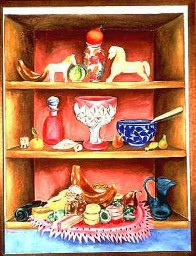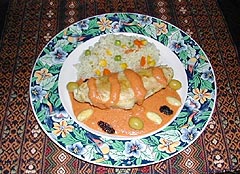Mexican Kitchen
Last month, the first part of this look at the Mexican kitchen focused on traditional utensils, primarily developed for the grinding and cooking of the Mesoamerican staple, corn. The modern appliances that perform the same basic functions were also described. This month, some essential techniques for the preparation of traditional Mexican dishes will be examined.
In the ancient Mexica empire, ritual was important at every stage of the meal, beginning with its preparation. The correct form of preparing corn for cooking was to blow on the kernels before putting them into the pot, to give them strength to face the heat. A kernel of corn which had fallen to the ground was to be picked up immediately; neglecting it was an insult that could cause ill fortune in the form of hunger or worse. A version of this belief persists to this day, with some women believing that burning a tortilla on the comal is bad luck.
 Although blowing on corn kernels has not endured as part of the repertoire of culinary techniques, there are a few that were unknown before the arrival of the Europeans. These have to do with the use of fats and oils, which were not used in cooking until the Spaniards brought cows and other livestock, as well as introducing olive oil to the New World. Despite the efforts of some anthropologists to try to prove that the people of Mesoamerica used edible plant oils, there is no evidence of any technology for grinding large quantities of plants and seeds to extract oil. Oil-bearing seeds may have been crushed and their oil used for flavorings, but certainly not in the amounts necessary for the cooking technique known as frying. Unlike most Mexican culinary practices, this one dates back no further than the Conquest.
Although blowing on corn kernels has not endured as part of the repertoire of culinary techniques, there are a few that were unknown before the arrival of the Europeans. These have to do with the use of fats and oils, which were not used in cooking until the Spaniards brought cows and other livestock, as well as introducing olive oil to the New World. Despite the efforts of some anthropologists to try to prove that the people of Mesoamerica used edible plant oils, there is no evidence of any technology for grinding large quantities of plants and seeds to extract oil. Oil-bearing seeds may have been crushed and their oil used for flavorings, but certainly not in the amounts necessary for the cooking technique known as frying. Unlike most Mexican culinary practices, this one dates back no further than the Conquest.
The other technique which was not known until the colonial period is conventional oven baking. True, underground pits such as the pib of the Maya were, and still are, used for cooking meat and corn dough dishes such as mucbil pollo; however, above-ground ovens were unknown until the Spanish introduced wheat and, with it, bread-baking. Colonial style wood-burning ovens, with their vaulted brick roofs, are still used today in many places. The famous pastes of Real del Monte, Hidalgo, are still baked in this type oven, using the original pastie recipe brought by British miners in the 1800’s.
Although cooking techniques such as boiling, baking, steaming, stewing, grilling and frying are used in many cuisines, there are other characteristic Mexican procedures which, although taken for granted in Mexican recipes, require some explanation for the foreign cook. The following is a description of each, as I have learned them from home cooks, who patiently explained, demonstrated, and watched as I made my own feeble first attempts at duplicating their techniques.
- Guisar: Stewing
- This is the most common way of cooking meat and poultry (with the possible exception of Northern Mexico, where much of it is grilled.) The meat, poultry and, in some cases, vegetables are prepared separately from the sauce in the making of mole, pipian and other complex dishes. The meat will sometimes be cooked in a pressure cooker and the sauce itself in a clay cazuela, then the two combined and simmered together in the cazuela before serving. The reason for this is that the long, slow simmering required to blend the flavors of the sauce generally takes longer than the time necessary to cook the meat. A heavy-bottomed Dutch oven is a good substitute for a cazuela when doing this long, slow type of cooking.
- Moler: Grinding
- This is traditionally done in a molcajete but today a blender is more frequently used. The molcajete allows more control over the final texture of a salsa; however, if the sauce is a smooth one, a blender does quite well. The process of grinding chiles, herbs, spices and tomatoes in a molcajete is labor-intensive, and an alternative is to grind dry ingredients, such as spices, in a spice or coffee mill before combining them with other ingredients. Whether using a molcajete, blender or food processor, garlic and salt should be ground together before adding the remaining ingredients. Dried corn for homemade tortillas has traditionally been ground on a metate, but nowadays even those who make tortillas at home most often have the corn ground in the neighborhood molino (mill.) Some traditional chocolate makers, especially in Oaxaca, grind the cacao on a warm metate.
- Tostar/Asar:
- Toasting or Dry-Roasting This is commonly done on the comal, but any well-seasoned griddle or dry skillet will work. It is a quick process, done over high heat and involving no liquid or oil. Tortillas, dried chiles and some sauce ingredients are toasted on a comal, griddle or dry skillet. Tortillas made from raw masa are “baked” on both sides after being formed, and store-bought or previously cooked tortillas are re-heated the same way. The tortilla should be heated on one side until it puffs up, then turned and heated on the other.
- Dried chiles should be washed and dried thoroughly before roasting, and then only roasted to the point of fragrance. Do not wait for a noticeable difference in color. Once a chile has been burned, its flavor will be bitter and it should be discarded.
- Tomatoes, onions and garlic are often roasted to intensify their flavors before being used in salsas and moles. Tomatoes should be roasted on a griddle or comal, turning them carefully with tongs, until their skins blister. In some dishes, especially chipotle salsas, the charred skins are left on, lending character to the final flavor and texture of the salsa.
- Onions may be peeled or not before roasting, according to the dish being prepared and the individual cook. They will turn golden brown, but should not be allowed to blacken. Mexicans use white onion, which has an intense flavor that is nicely mellowed by roasting.
- Garlic is roasted with the skin on. After a few minutes on a hot comal or griddle, it will move or “pop up” slightly. After each clove is charred on one side, turn it so that all sides are charred, then remove from the heat. The garlic will have softened slightly and the skin will slide off easily.
- Some spices, especially seeds such as cumin and sesame, are toasted on the comal before being ground with other ingredients. They should be toasted only to the point of fragrance and not allowed to burn.
- Sofreir: Soft-Frying/Sautéing
- Not much deep frying is done in Mexican cooking, with the exception of some street snacks which are cooked on a special type comal with a well in the center to hold oil or lard. A far more common technique is “soft-frying” or sautéing, which is done to soften ingredients and intensify their flavor. Dried chiles, for example, are sometimes soft-fried in combination with dry-roasting. Tortillas usually need to be soft-fried before being covered with sauce, as with enchiladas. Warming the tortilla in a little hot oil prevents it from falling apart when being dipped in the hot sauce, as happens with a dry tortilla. The oil should be very hot in order to prevent the tortilla from soaking up too much oil. (Even making tortillas crispy for tostadas can be accomplished with a minimum of oil if the oil is hot enough.)
- Poner a Sudar: Sweating
- This refers to the method used for removing the skins from fresh chiles, especially poblanos, which are usually cooked without skins, either for stuffing or for making rajas, strips of chiles which are used in a great number of dishes.
- The chiles are placed directly on a gas flame or under a broiler and roasted until they are charred all over, turning with tongs so that all sides come in contact with the flame. Although both flame-roasting and broiling produce the same results, most Mexican cooks prefer flame-roasting, because it is much easier to watch the chiles and turn them with the tongs when needed. The skin should be allowed to blacken but not to burn, which would cause holes to be cooked through the chile. When this is done, the chile is removed from the flame and placed in a plastic bag for 10-15 minutes, causing it to “sweat.” This release of moisture forms a narrow vacuum between the skin and the flesh, making it easy to slide the skin right off. Most Mexican recipes instruct the cook to do this “bajo el chorro de agua”- under running water.
- Desflemar: To Neutralize by Soaking
- This refers to taking the “bite” out of a hot fresh chile, or even a strong onion, by soaking in a solution of water with either vinegar or salt, both of which draw out the heat. If handling a fresh chile causes either coughing or watery eyes, this is a good indication that the chile will be quite hot, and soaking for one-half to one hour will help to neutralize it. Fresh jalapeños being prepared for stuffing may be soaked overnight in milk after being seeded.
 The following recipes have been taught to me by home cooks here in Mexico who have been using these culinary techniques literally from childhood, helping in their mothers’ kitchens and then cooking for their own children and grandchildren. I thank them for sharing their kitchens and their expertise.
The following recipes have been taught to me by home cooks here in Mexico who have been using these culinary techniques literally from childhood, helping in their mothers’ kitchens and then cooking for their own children and grandchildren. I thank them for sharing their kitchens and their expertise.
- Estofado de Pollo de Carmen Solis: Carmen Solis’ Chicken Estofado
- Puerco con Verdolagas de Juana Perez: Juana Perez’ Pork with Greens
